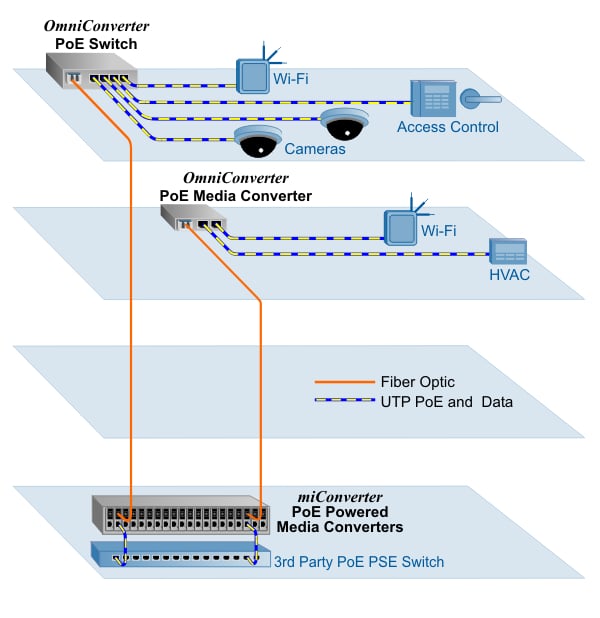Overview
Building Automation And Smart Buildings
The concept of building automation, or smart buildings, involves integrating all of a facility's systems into a centrally controlled network with IP-based structured cabling. Smart buildings provide several benefits, including improved safety, reduced labor and operating costs, simplified asset management and energy efficiency.
According to the market research report from Fortune Business Insights - the global smart building market is projected to grow from $67.60 billion in 2021 to $265.37 billion in 2028 at a CAGR of 21.6% in forecast period. The growth of this market is driven by the increase in demand for energy-efficient systems, the growing need for automation of security systems in buildings, and advancement of IoT in Building Automation Systems (BAS). Furthermore, the emergence of 5G technology and growing smart-projects is expected to create many opportunities for the growth of this global market.
Building Automation and PoE Devices
Building Automation Systems leverage the convergence of low-voltage building systems with an Ethernet network and IP addressable devices throughout the building. With an Ethernet network, all of the smart building devices can be connected to the network and powered by the same network cable. Power over Ethernet (PoE) allows system integrators or network administrators to deploy powered devices at any location, regardless if a site has electrical outlets. The devices connected to the PoE network in a smart building include:
- Access control door locks, badge readers, parking gates, turnstiles and intercoms
- Surveillance cameras
- Wi-Fi access points and routers
- Thin clients
- Synchronized clocks
- Electronic signage and emergency messaging systems
- Thermostats and HVAC controls
- Intelligent LED Lighting
Power over Ethernet is supplied by power sourcing switches that inject power over copper UTP cabling to all the devices in the building. These switches are located in a centralized network server room that controls the building system.
The challenge to network managers and system integrators is that in larger buildings and facilities with secure parking, the distance from the network server room to PoE devices will often exceed the 100 meter distance limits of UTP copper cabling. Fiber optic cabling overcomes the distance and bandwidth limitations of UTP, but fiber does not carry electric DC current.
OmniConverter PoE Power Sourcing Media Converters and PoE Fiber Switches enable fiber connectivity and Power over Ethernet for multiple smart building devices.
Products
Omnitron PoE Fiber Switches and Media Converters
OmniConverter® PoE Media Converters
OmniConverter PoE Media Converters enable distance extension over fiber optic cabling and provide PoE (15W), PoE+ (30W) and HPoE (60W) for one or two IP surveillance cameras.
OmniConverter PoE Fiber Switches
OmniConverter PoE Fiber Switches enable fiber network distance extension and provide PoE, PoE+, or HPoE on all RJ-45 ports for up to eight IP cameras. They are available with IP-based management via a web interface, Telnet or serial console interface.
Building Automation with PoE Application
Building Automation with PoE Application
In this building automation application diagram, OmniConverter PoE Media Converters and OmniConverter PoE Fiber Switches are used to extend distances to building automation devices that are outside the 100 meter distance limitation of UTP copper cabling. At the server room on the ground floor (bottom of the diagram), a PSE PoE switch is deployed to provide network connectivity and PoE power to local devices with copper UTP connectivity. A chassis of miConverter PoE/D PoE powered media converters are powered by the PoE switch with copper patch cables. The miConverter PoE/D can draw power only from the PoE switch, or have redundant power with AC power provided by the miConverter 18-Module Chassis. The copper is converted to fiber and multiple fiber runs are distributed throughout the building.
 iConverter, miConverter and FlexPoint media converters can also be installed in high-density rack-mount chassis to provide reliable and cost-effective fiber distribution from existing copper network equipment.
iConverter, miConverter and FlexPoint media converters can also be installed in high-density rack-mount chassis to provide reliable and cost-effective fiber distribution from existing copper network equipment.
On the top of the diagram, a fiber run to the top floor connects to an OmniConverter PoE Fiber Switch that powers up to eight PoE+ devices. Another fiber run connects to an OmniConverter PoE Media Converter that powers two PoE, PoE+ or HPoE devices. The PoE Media Converters and PoE Fiber Switches are located near convenient AC or DC power sources.










